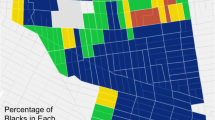Abstract
Despite previous research, no one has traced the roots and rise of African–American street gangs in Los Angeles as it relates to the development of racially and ethnically segregated areas. This paper examines the experiences of the early African–American community and explains the cultural phenomenon that led to the formation of African–American gangs. The rapid migration of African–Americans to the city caused their population in Los Angeles to increase, and this threatened the White community. As a result of racial discrimination and racial covenants, many African–Americans became trapped in Watts, which was formerly a White middle-class community of government employees and white-collar workers. This transformed South Central (Watts) into a ghetto of predominantly poor urban Black dwellers with low-paying jobs.
Similar content being viewed by others
References
Adler, P. (1977). Watts: From suburb to black ghetto. Ph.D. Dissertation, University of Southern California.
Alonso, A. (1999). Territoriality among African–American street gangs. Unpublished master’s thesis, University of Southern California.
Anderson, F. (1980). The development of leadership and organization building: in the black community of Los Angeles. From 1900 through World War II. Saratoga: Century Twenty One Publishing.
Blanc, C. S. (1995). Urban children in distress: global predicaments and innovative strategies. Florence: UNICEF. with contributors.
Bond, J. (1936). The negro in Los Angeles. Ph.D. Dissertation, University of Southern California.
Bullock, P. (Ed.). (1969). Watts: the aftermath: an inside view of the ghetto bv the people of Watts. NewYork: Grove Press.
Collins, K. (1980). Black Los Angeles: the maturing of the ghetto. 1940-1950. Saratoga: Century Twenty One Publishing.
Covey, H. C., Menard, S., & Franzese, R. J. (1992). Juvenile gangs. Springfield: Charles C. Thomas Pub.
Cureton, S. (2008). Hoover Crips: when cripin’ becomes a way of life. Lanham: University Press of America.
Davis, M. (1992). City of quartz: excavating the future in Los Angeles. London: Vintage.
DeGraaf, L. (1962). Negro migration to Los Angeles, 1930 to 1950. Dissertation, University of California, Los Angeles.
DeGraaf, L. (1970). The city of black angels: emergence of the Los Angeles ghetto, 1890-1930. Pacific Historical Review, 39(3), 323–352.
DeGraaf, L. (1980). Race, sex, and region: black women in the American west, 1850-1920. Pacific Historical Review, 49(2), 285–313.
Dixson, A. D., & Rousseau, C. K. (Eds.). (2006). Critical race theory in education: all god’s children got a song. New York: Routledge.
Du Bois, W.E.B. (1914, September 5). Colored California. Los Angeles California Eagle.
Ervin, J. (1931). The participation of the negro in the community life of Los Angeles. MA Thesis, University of Southern California.
Forbes, J. (1968). Afro-Americans in the far west: a handbook for educators. Berkeley: Far West Laboratory for Educational Research and Development.
Garcia, M. (1985). Adaptation strategies of the Los Angeles black community. 1883-1919. Ph.D. Dissertation, University of California, Irvine.
Gilje, P.A. (1996). Rioting in America: Interdisciplinary studies in history. Bloomington: Indiana University Press.
Greer. (1952). Participation of ethnic minorities in the labor unions of Los Angeles county. Ph.D. Dissertation, University of California, Los Angeles.
Hazlehurst, K., & Hazlehurst, C. (Eds.). (1998). Gangs and youth subcultures: international explorations. New Brunswick: Transaction Pub.
Katz, W. (1987). The black west. Seattle: Open Hand Publishing, Inc.
Klein, N., & Schiesl, M. (Eds.). (1990). 20th century Los Angeles: Power, promotion, and social conflict. Claremont: Regina Books. 1990.
Lapp, R. (1987). Afro-Americans in California. San Francisco: Boyd & Fraser Publishing Co.
Melching, R. (1974). The activities of the Ku Klux Klan in Anaheim, California 1923-1925. Southern California Quarterly, 56(2), 175–195.
Northrup, H. (1944). Organized labor and the negro. New York: Harper & Bros.
Smith, A. (1978). Black employment in the Los Angeles area. 1938-1948. Ph.D. Dissertation, University of California, Los Angeles.
Snider, P. (1977). An anthropological description of street gangs in the Los Angeles area. Santa Monica: RAND, report for the Department of Justice.
Stoll, M. (2000). Search, discrimination, and the travel to Work. In L. Bobo et al. (Eds.), Prismatic metropolis: inequality in Los Angeles (pp. 417–452). New York: Russell Sage Foundation.
Tolbert, E. (1980). The UNIA and black Los Angeles: Ideology and community in the American Garvey movement. Los Angeles: The University of California, Los Angeles [Center for Afro-American Studies].
Vigil, J.D. (1987). Organized and chaired session-youth gangs and delinquency: a cross-cultural look at the children of immigrants. 47th Annual Meeting, Society for Applied Anthropology, Oaxaca, Mexico, April 8-12.
Vigil, J. D. (1988a). Barrio gangs: street life and identity in Southern California. Austin: University of Texas Press.
Vigil, J. D. (1988b). Group processes and street identity: adolescent Chicano gang members. Ethnos, 16(4), 421–445.
Vigil, J. D. (2002). A rainbow of gangs: street cultures in the mega-city. Austin: University of Texas Press.
Author information
Authors and Affiliations
Corresponding author
Rights and permissions
About this article
Cite this article
Brown, G.C., Vigil, J.D. & Taylor, E.R. The Ghettoization of Blacks in Los Angeles: The Emergence of Street Gangs. J Afr Am St 16, 209–225 (2012). https://doi.org/10.1007/s12111-012-9212-7
Published:
Issue Date:
DOI: https://doi.org/10.1007/s12111-012-9212-7




